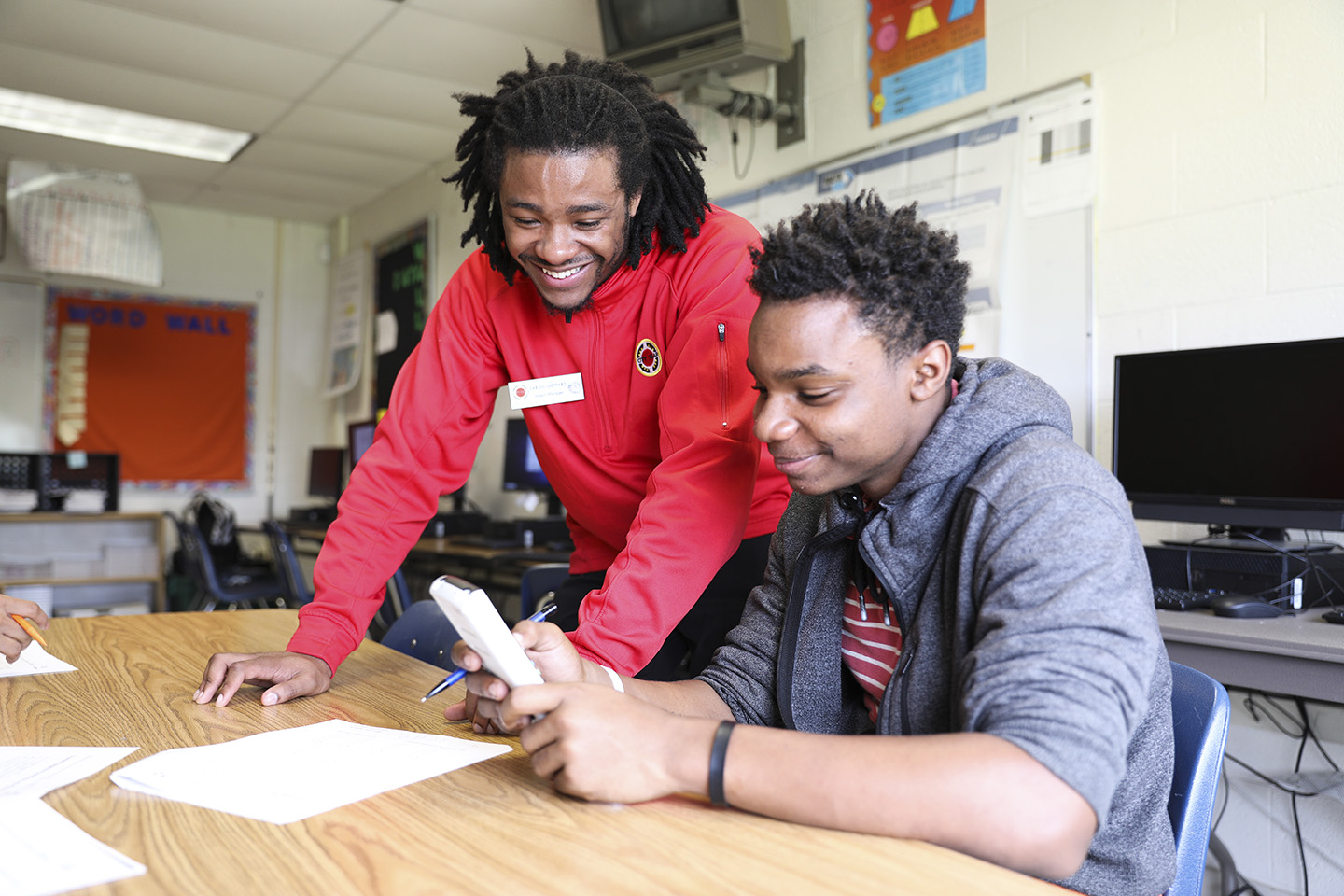Creating environments for learning math
When City Year AmeriCorps members first walk into a school to serve as student success coaches, they work hard to put their best foot forward to set up strong relationships with their teammates, students and partner teachers. One particularly important conversation is how AmeriCorps members can support students academically and, in particular, in building their math skills throughout the school year.
Some questions corps member and their partner teachers might ask each other can include:
- Which students need additional support?
- What skills should we focus on in the next few weeks to set up everyone for success?
- Which students work best together? Which students work better independently?
How to create an environment for learning math

It’s important to establish what being a “math learner” means. Kristen Olmsted, City Year’s senior director of math, describes being a math learner as someone who is “open to curiosity and exploration. And being open to the idea of building on what you know to figure out what you don’t know.” When you have a math learner mindset, “you’re giving yourself permission to make mistakes because you’re able to learn and grow from them,” affirms Olmsted.
“We’re doing children a disservice by introducing them to this notion of a ‘math person,’” David Ansari, a professor of psychology and education at the University of Ontario, told the New York Times. This is because anyone, regardless of age, can improve their math skills with practice. You can be bad at the four times table today and a pro at the eight times table the next year. Learning is on a continuum and never stagnant.
Along with establishing a learner mindset, corps members can create an engaging and welcoming learning environment by creating small groups. Small group settings give students more individualized attention, an opportunity to learn from each other, and have fun as they build their confidence with math concepts.
During the first few weeks of class, get to know each student and observe any classroom dynamics. Your partner teacher will also have a lot of insight into a student’s test scores from the previous grade and their personality so don’t be afraid to ask them questions as well. These insights can guide what topics a student needs support in, their learning style and how students can work with each other.
There may be times where a student may work well in a group one day but then work independently the next. That’s okay! Small groups do not need to be set in stone. If a student is learning and able to vocalize their needs, you have created a conducive learning environment.
Make room for frustration with math
Learning new skills can be a rollercoaster of wins and setbacks.
According to the American Psychological Association math anxiety “frequently causes distress, disrupts the use of working memory for maintaining task focus, negatively affects achievement scores, and potentially results in dislike and avoidance of all math-related tasks.” According to a study by the University of Oxford, children as young as seven have shown signs of math anxiety.
Math anxiety is a common issue educators come across. However, 1:1 tutoring has been shown to help reduce math anxiety in students. Corps members are present throughout the school day and build relationships with students that allow their learning styles and interests to be easily integrated into a math session.
When corps members build relationships with students and provide them with consistent support, students feel seen. Olmsted says, “when students [feel] comfortable, they know who to reach out to and are willing to reach out.”
While incorporating student interests and finding new ways of engagement is important, a major benefit of 1:1 or small group learning is being able to hit the pause button. “Brain breaks” help students refocus after a long day of learning.
Your math toolkit
The kinds of tools and resources you use will depend on your student’s grade level and interests. City Year AmeriCorps members serve students in third through ninth grade and each of our 29 U.S. locations provide their school teams with basic resources, such as flashcards and worksheets, in addition to ongoing professional development and support throughout the school year.
A typical math toolkit for third and fourth grade students may include flashcards for addition and subtraction whereas flashcards for fifth grade students would include multiplication, for example.
You can also leverage your surroundings in a variety of fun ways. Does your classroom have square tiles? You can have students hop on the squares to represent a number line.
How about a trash can? Incorporate a game of “trashketball” into a lesson.
There are many ways to have fun with your math space. You can always ask your student what they find interesting to create a collaborative learning environment.
Related stories
Every year, thousands of young people decide to join AmeriCorps programs for a year (or more!) of service, helping to...
Read more about Everything you need to know about returning for another year as a City Year AmeriCorps memberCity Year is committed to providing our AmeriCorps members with resources, opportunities and support that help them to achieve their...
Read more about Empowering Futures: City Year Baton Rouge’s Partnership with Bottom LineFatimah Abdulmateen takes service seriously. Fatimah served two years with City Year as an AmeriCorps member, making her an alum...
Read more about A City Year alum with a passion for service—both here and abroadThough this part of the City Year experience may be particularly challenging, it’s also normal! And we want you to...
Read more about The “mid-fall slump” in schools is real--here's what to expect















